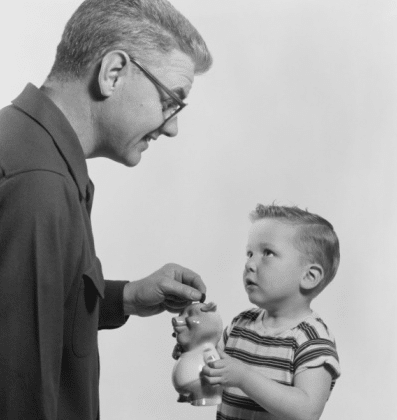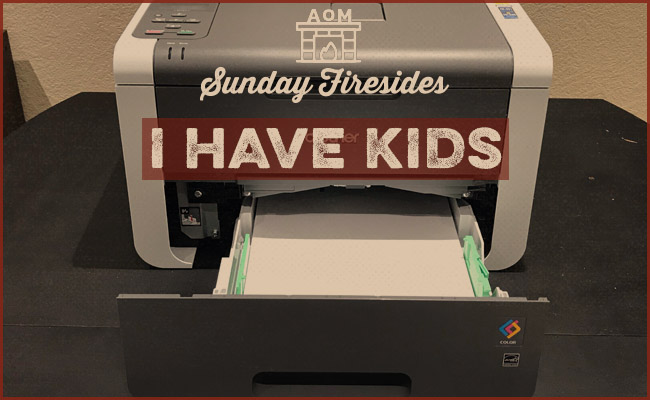
“Dad, I want those Hot Wheels cars. Will you get them for me? You have money.”
A few months ago, Kate and I noticed that our young son Gus had started picking up on the fact that stuff isn’t free. He realized you need money to buy food, clothes, and yes, even Hot Wheels. When Gus started asking us to buy him toys when we were out shopping, we figured it was time to begin paying him an allowance.
Yet I had a lot of questions: Should his allowance be tied to doing chores? How much should we give him? Should we have him put his money in a real bank account? Giving an allowance is one of the first and best ways to teach kids about managing their money, and I really wanted to implement a method that would teach him sound budgeting and financial principles.
To figure out the answers to my questions and come up with best practices, I did a lot of research. Below I share what I’ve learned for you other dads out there looking to raise savvy money managers.
The Big Debate: Should You Tie Allowance to Chores or Not?
The big debate that you see on finance and parenting blogs is whether or not you should tie allowance to chores; that is, should your kid have to earn their allowance by doing certain household tasks?
Your kneejerk answer will likely be “Of course!” But it’s actually a surprisingly tough question to answer because each side has its pros and cons:
The Case for Tying Allowance To Chores
Most parents believe that an allowance should be connected to chores. In fact, a survey conducted by T. Rowe Price found that 86% of parents think kids should only get paid if they help out around the house. It definitely makes intuitive sense to tie allowance to chores because it teaches kids how money works in the real world — if you want to get paid, you have to work.
The parents in the allowance-for-chores camp argue that if you simply give your child money, they’ll become spoiled and entitled. If you want to teach your children a solid work ethic, the thinking goes, you need to show them that rewards only come to those who earn them.
The Case for Giving an Allowance Not Contingent on Chores
The parents and financial experts in the no-strings-attached allowance camp argue that the main focus of allowance shouldn’t be work, but rather teaching children about how to manage money and save for long-term goals. When parents tie allowance to chores, they often just focus on their children getting their tasks done, instead of on managing the money they get in return.
This side also argues that by tying allowance to chores, you’re teaching children that you only need to contribute to the family if you get money in exchange. Mom and dad don’t get paid for doing work around the home, so why should children?
Thus, this camp believes that by tying allowance to chores, you’re actually preventing kids from developing a healthy work ethic, rather than inculcating one. Instead of teaching kids to work hard and do good work for the sake of working hard and doing good work, you teach them that you should only make an effort if there’s money on the line.
What’s more, paying allowance for chores may even create a perverse incentive in your children not to do chores. Your kids may decide that it’s worth missing a few weeks of allowance to avoid taking out the trash, clearing the table after dinner, or cleaning their room. What are you supposed to do then to get them do their chores?
Compromise Between the Two Camps
I certainly want my kids to learn that in the real world, the way you make money is to exchange your work for it. At the same time, I want to make the focus of allowance about managing money and learning how to save for long-term goals. I also want to teach my kids that there are certain jobs you have to do simply because you’re a member of the family.
Fortunately, there are several ways to find a compromise between the two above philosophies. One way is to divide chores around the house into two groups: Citizen of the Household Chores and Pay for Work Chores. Citizen of the Household Chores are those that must be done simply because you live in the house. Allowance is not tied to them. If your children fail to perform these chores, you can dole out age-appropriate punishments like sending them to timeout or taking away their screentime. Pay for Work chores, on the other hand, are the chores children have to do to earn their allowance. If they don’t do them, they don’t get their dough.
This compromise helps avoid the problem of kids opting out of allowance to avoid certain chores, but still develops the connection between work and money.
Another compromise solution highlighted in The Opposite of Spoiled is to pay children a base allowance that they get no matter what — a kind of living stipend. The kid has to do basic chores for free, just like mom and dad, but you will pay Junior extra money if he recognizes a problem around the house and solves it. So if your kid notices that the car is dirty and offers to clean it, you can negotiate a rate and he’ll get paid for that job. Personally, I’m attracted to this compromise because I like how it encourages entrepreneurial thinking in kids.
Right now, Kate and I are paying Gus an allowance that isn’t tied to specific chores. He’s got stuff he has to help with around the house — like unloading the dishwasher and keeping his room and playroom clean — simply because he’s a member of our family. Our main goal with allowance is to teach Gus money management and patience with saving up for long-term goals. As he gets older and capable of doing more tasks, we’ll be adding in some bigger chores that are connected with money.
Make Your Kid a Money Genius – Listen to My Podcast With Beth Kobliner
When Should You Start Paying Kids an Allowance?
If your kiddo knows how to do some basic math and is starting to ask questions about how much things cost, then chances are she’s ready for an allowance.
When this awareness and skill will come “online” will vary from child to child. Gus is only four, but he’s always been precocious, and can already read, count money, and do double-digit math problems, so we felt he was ready.
Use your discernment in determining when your child is capable of handling an allowance. Keep in mind that they don’t need to be savvy money mangers right out of the gate; at first they’ll probably be excited and want to immediately blow their weekly allotment. Learning delayed gratification will take time and experimentation on their part as to how saving and spending works. It’s all part of the learning process.
How Much Allowance Should You Pay?

After you’ve decided to start paying your kiddo an allowance, you’ll need to decide how much green to dole out. If your main purpose of allowance is to teach kids the value of patience and delayed gratification, then you don’t want to give them so much money that they can buy pretty much whatever they want as soon as they get paid. You want them to have to scrimp and save up over time to get what they want.
A common recommendation that I came across from financial experts is to pay $1 each week per year of age. We do this rate with Gus, so he’s getting $4 a week. As your kids get older and into middle school, they may require more money if they’re paying for clothes and lunches.
Helping Kids Manage Their Money: Three Jars
As we’ve mentioned throughout this post, the primary purpose of allowance is to teach kids about managing money. That’s why when you start paying an allowance, you don’t just give them the money carte blanche. You need to set some rules and guidelines for spending and saving.

A great way to do this with younger children is to set up the Three Jar System. Go to the store and buy three big mason jars. With a Sharpie, label one jar “Spend,” another jar “Save,” and the third “Give.”
The day you decide to start paying allowance, bring the jars to your family meeting and explain to your kiddo that she’s going to start getting an allowance. But then explain that there are some conditional guidelines attached to the money. Before she can spend her money, she has to set aside some for saving and some for giving too — it’s never too early to start teaching children about being charitable.
How much they need to save and set aside for giving will vary from family to family. You could do percentages, but that’s pretty tricky for a little kid to understand. With Gus, we’ve told him that he needs to put aside — at a minimum — $.25 in his giving jar and $.75 in his savings. That’s roughly 7% for giving and 20% for savings.
The rest of the money he can spend on whatever he wants (within reason). If he wants something that costs more than the $3 he has left, he’ll need to save up until he has enough money for it.
It’s been interesting to see Gus grapple with short-term and long-term wants. Gus likes gum and mints, so that’s what he often spends his money on. Whenever he wants a pack of $2 gum, I’ll take time to show him the price label and walk through the math with him so he fully understands that he’ll only have $1 of spending money left until next week. If he’s been talking about a Lego set he wants, I’ll remind him that he won’t have enough money to buy that if he buys the gum now. You can see the gears grinding in his head as he tries to figure out if he wants the gum right now or if he’d be better off saving and buying his Legos later. Occasionally, he’s able to delay gratification, but usually he gives in and buys the pack of gum; his powers of delayed gratification are still nascent, but will hopefully develop over time as he gets a firmer and firmer grasp of how the world works.
When Gus starts whining about still wanting that Lego set, Kate and I remind him he’ll need to not buy gum next time and save more of his money. Life is hard for a suburban four-year-old.
When kids are young, the savings jar should be used for short-term goals. A four-year-old probably isn’t going to understand or appreciate the concept of saving for his retirement. A year seems like a decade away; seventy years probably seems like an eternity. So right now, the savings jar for Gus is for socking away money for toys he might want that cost more than $3. It will usually take a few weeks before he has enough for the thing he wants, so he learns the importance of setting goals and being patient.
As your kids get older, you might consider adding in long-term savings goals like college education and even retirement. You can even set up more elaborate savings systems. Some parents have a matching system similar to what some companies do with 401(K)s, in which they’ll match how much their kids put away up to a certain amount. That can be a great way to incentivize older children to save for important long-term goals.
The giving jar is to help teach your children the value and joy of giving your money to individuals and groups who need it. Where can the kids give the money? Well, if you belong to a church, they could put it in the collection basket. Or you could have your kid decide on a charity that he wants to give his money to and set a savings goal with him. Once he has the designated amount, you can write a check or make a donation on his behalf online with your debit or credit card.
Should You Use a Bank?
Financial experts generally agree that when kids are young, it’s better that they get paid in cash and keep their money in a physical container that they can see. Putting the money in a bank makes it too ethereal for tiny brains that are still working to understand abstractions. The jar full of cash is much easier for them to grasp than a digital number in some bank account. So until about age ten or eleven, keep your child’s money in the jars, but talk to him about how mom and dad keep their money in a bank. One of my weekly routines with Gus is to take him to the bank with me to deposit business checks. Every time we go I talk to him about why mom and dad keep their money in a bank and that one day he can do the same thing, too. He thinks that’s pretty cool.
When the kids are about twelve (or if they ask earlier on their own accord) open up that savings or checking account. From there, you can get more grown-up with how you dispense allowance. For example, you can transfer your children’s allowance into their checking account sort of like direct deposit. From there, it’s up to them to siphon money into its appropriate spend, save, or give accounts. There are also apps that you can use to help manage your child’s allowance. FamZoo allow you to assign chores to your kids. When they complete their chores, they accrue a balance online that can be used to make online purchases or that can be transferred to a checking account.
Stay Consistent
The key with allowance, as with anything when it comes to your children, is consistency. If you’re going to pay an allowance, make sure you do it every week. If your kid wants something that isn’t a basic life need, make them use their allowance money. If you deviate just once from that mandate, your kids will start picking up on the fact that mom and dad’s rules are malleable, and that if they whine enough, you’ll get them things they can’t afford themselves.
Allowance is a foundational tool for teaching your kids money management as well as delayed gratification and patience. As they get older, you can build off the lessons they learned with their allowance to teach more advanced financial principles.







